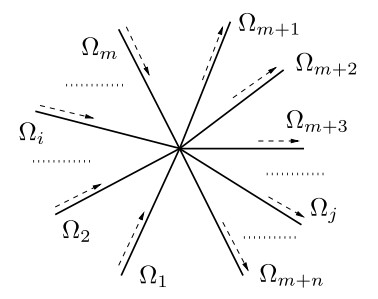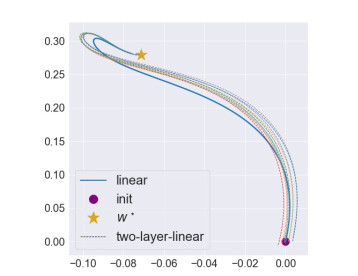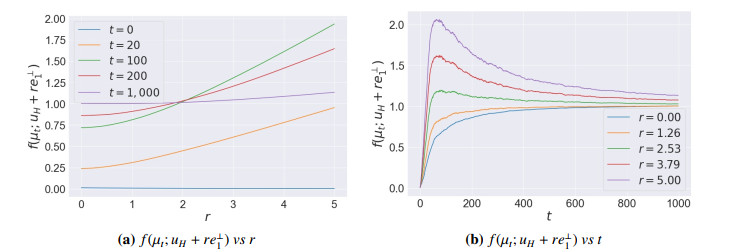1.
Introduction
We consider a family of scalar conservation laws defined on an oriented graph Γ consisting of m incoming and n outgoing edges Ωℓ, ℓ=1,…m+n joining at a single vertex. Incoming edges are parametrized by x∈(−∞,0] while outgoing edges by x∈[0,∞) in such a way that the junction is always located at x=0. We use the index i, i=1,…,m, to refer to incoming edges and j, j=m+1,…,m+n, for the outgoing ones.
On the edge Ωℓ we introduce a scalar conservation law, describing the evolution of a density ρℓ. Then on the incoming edges we have
and on the outgoing ones
The fluxes f1,...,fm+n, differ in general, however we assume that they are bell-shaped (unimodal), Lipschitz and non-degenerate nonlinear, i.e.
(H.1) for each ℓ∈{1,...,m+n}, fℓ∈C2([0,1]), f(0)=f(1)=0, fℓ≥0, and there exist ¯ρℓ∈(0,1) such that f′ℓ(ρ)(¯ρℓ−ρ)>0 for every ρ∈[0,1]∖{¯ρℓ};
(H.2) for any ℓ∈{1,...,m+n}, |{ρ:f″ℓ(ρ)=0}|=0.
We augment (1) and (2) with the initial conditions
assuming that
(H.3) ρ1,0,...,ρm,0∈L1(−∞,0)∩BV(−∞,0),
ρm+1,0,...,ρm+n,0∈L1(0,∞)∩BV(0,∞)
and 0≤ρ1,0,...,ρm+n,0≤1.
Finally, we introduce the necessary conservation assumption at the node, which transforms our family of independent equations into a single problem
Questions related to existence, uniqueness and stability of solutions for problems of this kind have been extensively investigated in recent years, mainly in relation with traffic modeling. The interested reader can refer to [7,13] for an overview of the subject. Here our point of view is different, as we do not focus on a specific model. We consider a parabolic regularization of the problem, similarly to what has been done in [11,10], but instead of enforcing a continuity condition at the node for the regularized solutions, we introduce a more general set of transmission conditions on the parabolic fluxes.
In this work we adopt the following definition of weak solution for the problem (1), (2), and (3). We stress that this definition is for sure not sufficient to ensure uniqueness. On the contrary it fix somehow a minimal set of properties that any reasonable solution is expected to satisfy, see [3] and references therein for a more detailed discussion on this point.
Definition 1.1. Let ρ1,...,ρm:[0,∞)×(−∞,0]→R and ρm+1,...,ρm+n:[0,∞)×[0,∞)→R be functions. We say that (ρ1,....,ρm+n) is a weak solution of (1), (2), and (3) if
(D.1) f1(ρ1),...,fm(ρm)∈BVloc((0,∞)×(−∞,0)) and fm+1(ρm+1),...,fm+n(ρm+n)∈BVloc((0,∞)×(0,∞));
(D.2) for every i∈{1,...,m}, every c∈R and every nonnegative test function φ∈C∞(R×(−∞,0)) with compact support
(D.3) for every j∈{m+1,...,m+n}, every c∈R and every nonnegative test function φ∈C∞(R×(0,∞)) with compact support
(D.4) m∑i=1fi(ρi(t,0−))=m+n∑j=m+1fj(ρj(t,0+)) for a.e. t≥0.
In [10] the authors approximated (1), (2), and (3) in the following way
where i∈{1,...,m} and j∈{m+1,...,m+n} and ρi,0,ε,ρj,0,ε are smooth approximations of ρi,0,ρj,0. In this setting they showed that
where (ρ1,....,ρm+n) is a weak solution of (1), (2), (3), in the sense of Definition 1.1.
In this paper we modify the transmission condition of (4) and inspired by [14] we consider the following viscous approximation of (1), (2), and (3)
where, of course,
The additional assumptions we make on the functions βℓ and on the initial conditions ρℓ,0,ε are postposed to the next section.
The main result of the paper is the following.
Theorem 1.2. Assume(H.1), (H.2), and (H.3). There exist a sequence {εk}k∈N⊂(0,∞), εk→0, and a solution (ρ1,…,ρm+n) of (1), (2), and (3), in the sense of Definition 1.1, such that
for every 1≤p<∞,i∈{1,..,m},j∈{m+1,..,m+n}, where (ρ1,εk,...,ρm+n,εk) is the corresponding solution of (5).
It worth mentioning that a complete characterization of the limit solution obtained from (4) as ε→0 is given in [3], where the authors adapt to a star shaped graph setting some ideas and techniques originally developed for conservation laws with discontinous flux, see in particular [2,4,5].
At the moment we are not able to formulate a similar characterization of the limit of (5). In general, however, the limits coming from parabolic regularization subject to the two different kinds of transmission conditions are different.
To show this consider the simple case of a junction with one incoming and one outgoing edges. So we have the conservation law
on the incoming edge and
on the outgoing one. Assume that
Consider the simplified version of (5)
The unique solution of (13) is
Therefore, as ε→0 we get the solution of (10)-(11)
This stationary solution is not admissible in the sense of the classical vanishing viscosity germ, see [5,Sec. 5], as it consists of a nonclassical shock. However, when dealing with conservation laws with discontinuous flux, it is well known that infinitely many L1 contractive semigroups of solutions exist, also in relation with different physical applications. In particular, when the right and left fluxes are bell-shaped, as we assume in condition (H.1), each of those notions of admissible solution is uniquely determined by the choice of a (A,B)-connection, see [1,5,9,12] for precise definitions and exemples. In the exemple above the couple (ˆρ,ˇρ) is a connection.
It is worth noticing that entropy solutions admissible in the sense of a (A,B)-connection can be obtained as limits of a sequence of parabolic approximations made with adapted viscosities but a classical condition of continuity at the interface, see [5,Sec. 6.2] for a general result, but also [2,15] for an application to the Buckley-Leverett equation.
It is difficult, however, to establish a direct equivalence between the aforementioned results and the one we put forward in this paper. In particular, in the present case we miss information on the boundary layers at the parabolic level and we do not know how the transmission conditions we impose on the parabolic fluxes translates into a condition for the hyperbolic problem.
This means in particular that we have little information on the germ associated to the family of limit solutions obtained in Theorem 1.2 and, so far, we have not been able to prove that this germ is L1-dissipative. We conjecture, however, that this is due to a technical obstruction and that uniqueness of the limit solutions holds.
The paper is organized as follows: Section 2 contains the precise list of assumptions on the initial and transmission conditions in the parabolic problem (5). In Section 3 we present the proofs of all necessary a priori estimates on (5). Finally, in Section 4 we detail the proof of Theorem 1.2.
2.
Initial and transmission conditions for the parabolic problem
The initial conditions ρℓ,0, ℓ=1,…,m+n, on the hyperbolic problem (1), (2), and (3) satisfy (H.3).
Once the functions ρℓ,0 are fixed, we impose on (5) initial conditions ρℓ,0,ε such that
for some constant C>0 independent on ε.
The functions βℓ appearing in the transmission conditions in (5) take the form
for i∈{1,…,m}, and for j∈{m+1,…,m+n}
The functions Gi,j(u,v)∈C∞(R2), i∈{1,…,m}, j∈{m+1,…,m+n}, and Kh,ℓ(u,v)∈C∞(R2), h,ℓ∈{1,…,m+n}, satisfy
In particular, (19) implies
where χ(−∞,0) is the characteristic function of the set (−∞,0).
This specific form of transmission conditions is reminiscent of the parabolic transmission conditions considered in [14,8], which were originally inspired from the Kedem-Katchalsky conditions for membrane permeability introduced in [16]
for some constants ch,ℓ>0. Our conditions are more general and in particular we can notice that the function Gh,ℓ above satisfies
that allows the authors in [14] to get the L2 conservation (see Lemma 3.3 below).
We can observe that the equality (6) holds as
and analogously
3.
A priori estimates
This section is devoted to establish a priori estimates, uniform with respect to ε, which are necessary toward the proof of our main convergence result in the next section.
For every ε>0, let (ρ1,ε,...,ρm+n,ε) be a solution of (5) satisfying (16).
Lemma 3.1 (L∞ estimate). We have that
Proof. Consider the function
Since
using (19) we obtain
where δ{ρi,ε=0} and δ{ρj,ε=0} are the Dirac deltas concentrated on the sets {ρi,ε=0} and {ρj,ε=0}, respectively and we apply [6,Lemma 2] to compute the value of the integrals as a limit. Integrating over (0,t) and using (16) we get
and then
that proves the lower bounds in (25). The upper bounds in (25) can be proved in the same way using the function ξ↦(ξ−1)χ(1,∞)(ξ).
Lemma 3.2 (L1 estimate). We have that
Proof. Thanks to (5), (23), (24), and (25), we have that
Integrating over (0,t) and using (16) we get (26).
Lemma 3.3 (L2 estimate). We have that
for every t≥0.
Proof. Thanks to (5), we have that
Integrating over (0,t) and using (16) we get (27).
Lemma 3.4 (BV estimate). We have that
for every t≥0.
Proof. From (5) we get
Thanks to (20), we have that
where δ{∂tρi,ε=0} and δ{∂tρj,ε=0} are the Dirac deltas concentrated on the sets {∂tρi,ε=0} and {∂tρj,ε=0}, respectively and we apply [6,Lemma 2].
Integrating over (0,t) and using (16), (25) we get
that is (28).
Lemma 3.5 (Stability estimate). Let (ρ1,ε,...,ρm+n,ε) and (¯ρ1,ε,...,¯ρm+n,ε) be two solutions of (5). The following estimate holds
Proof. From (5) we get
Thanks to (5), (20), and (25), we have that
where we use [6,Lemma 2] and we denote by δ{ρi,ε=¯ρi,ε} and δ{ρj,ε=¯ρj,ε} respectively the Dirac deltas concentrated on the sets {ρi,ε=¯ρi,ε} and {ρj,ε=¯ρj,ε}.
Integrating over (0,t) we get (29).
4.
Proof of Theorem 1.2
The well-posedness of smooth solutions for (5) can be proved following the argument used in [10,Theorem 1.2] to establish the well-posedness of smooth solutions for (4). Indeed, the existence of a linear semigroup of solutions in the linear case (i.e., when fℓ≡0) is shown in [14]. Then the Duhamel Formula, estimates similar to the ones in the previous section and a fixed point argument lead to the result.
The main result of this section is the following.
Lemma 4.1. Let (ρ1,ε,...,ρm+n,ε) be the solution of (5). There exist a sequence {εk}k∈N⊂(0,∞),εk→0, and m+n maps ρ1,...,ρm+n such that
for every 1≤p<∞,i∈{1,..,m},j∈{m+1,..,m+n}. Moreover, we have that
Thanks to the genuine nonlinearity of f1,...,fm+n, we can use the Tartar compensated compactness method [18] to obtain strong convergence of a subsequence of viscosity approximations. The notation R can stand for (0,∞) or (−∞,0).
Theorem 4.2 (Tartar). Let
{vν}ν>0 be a family of functions defined on (0,∞)×R such that
and the family
is compact in H−1loc((0,∞)×R), for every convex η∈C2(R), where q′ℓ=f′ℓη′. Then there exist a sequence {νn}n∈N⊂(0,∞),νn→0, and a map v∈L∞((0,T)×R),T>0, such that
The following compact embedding of Murat [17] is useful.
Theorem 4.3 (Murat). Let Ω be a bounded open subset of RN, N≥2. Suppose the sequence {Ln}n∈N of distributions is bounded in W−1,∞(Ω). Suppose also that
where {L1,n}n∈N lies in a compact subset of H−1loc(Ω) and {L2,n}n∈N lies in a bounded subset of L1loc(Ω). Then {Ln}n∈N lies in a compact subset of H−1loc(Ω).
Proof of Lemma 4.1. Let us fix i∈{1,...,m} and prove the lemma for the incoming edges, as the proof for the outgoing ones is analogous.
Let η:R→R be any convex C2 entropy function, and let qi:R→R be the corresponding entropy flux defined by q′i=η′f′i. By multiplying i−th equation in (5) by η′(ρi,ε) and using the chain rule, we get
We claim that
Indeed, (25) and (27) imply
Due to (16), (39) follows. Therefore, Theorems 4.3 and 4.2 give the existence of a subsequence {ρi,εk}k∈N and a limit function ρi satisfying (30) such that as k→∞
that guarantees (32) and (33).
Finally, thanks to Lemmas 3.2, 3.3, and 3.4 we have (35), (36), and (37).
Proof of Theorem 1.2.. The first part of the statement related to the convergence of vanishing viscosity approximations has been proved in Lemma 4.1.
Let us fix i∈{1,…,m} and prove (9) for the incoming edges, the case of the outgoing ones is analogous.
Thanks to (3.4) and (33), for all φ∈C∞((0,∞)×(−∞,0)) with compact support, we have
therefore
where M((0,∞)×(−∞,0)) is the set of all Radon measures on (0,∞)×(−∞,0). Moreover, from the equations in (1) and (2) we have also
Clearly (41) and (42) give (9) and so the trace at the junction f(ρi(t,0−)) exists for a.e. t>0.
We prove now that the identity
holds for a.e. t>0; consequently the functions ρ1,…,ρm+n provide a solution to (1), (2), and (3) in the sense of Definition 1.1.
Let φ∈C1([0,∞)),φ(0)=0 with compact support. Consider the sequence {rν}ν∈N∖{0}⊂C2([0,∞)) of cut-off functions satisfying
for every x≥0 and ν≥1. Moreover, for every ν≥1, we define the sequence {˜rν}ν∈N∖{0}⊂C2((−∞,0]) by writing ˜rν(x)=rν(−x) for every x≤0.
From (5) we have that
As k→∞, due to (27), (33), and (34),
Finally, sending ν→∞,
that gives (43).










 DownLoad:
DownLoad:





